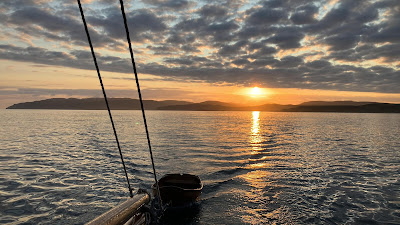We spent Friday visiting Brodick Castle, walking there and back along the Fisherman's Path. We were due a change in the weather, and it was cold, with a fair bit of drizzle off and on. We got back to Robinetta late afternoon, and decided to have a quite evening on the mooring rather than trying to go anywhere.
We wanted to make the most of the tide heading up the Clyde, so warmed up the engine and released the mooring at 06:45. There was a bit of a miscommunication between foredeck and helm on departure. I thought Julian said "Helm to port", while he actually said "Buoy to port". This resulted in Robinetta running over the pick up line, and we did catch on it for a short while. (When I checked astern the mooring buoy was trying to follow us.) Luckily a quick burst of astern before putting the engine in neutral saw the mooring drift towards the bow again, and the pick up buoy reappeared.
The weather was overcast, and the wind very light, but we knew it was due to get up to a force 5 later, so Julian bent on the no 2 jib for the first time this trip. We went head to wind and raised the full main straight after breakfast. The wind was from dead astern, so I set the preventor but the breeze was so light the engine stayed on for another hour.
At the start of the day Julian had agreed to set a course so we would have an ETA to give our son who was expecting us for dinner. He did not think we really needed it for anything else since we could just head between Bute and the Cumbraes as we left Arran. However I was very glad of it when both our aiming points disappeared into the murk! Visibility was only really bad for about 15 minutes, and as the fog cleared the wind came up and the engine went off at 08:36.
We sailed along happily at just over 4 knots until we were between Bute and Little Cumbrae. Julian was helming, and beginning to find it hard work, and when I glanced behind I could see more white horses than I was expecting. I nipped across the cabin top and took off the preventor while Julian put the engine on, then we went head to wind to reef.
Reefing is normally easy. This was not. The throat halyard got stuck on something, and Julian had to go forward to free it. The problem line turned out to be one of the topping lifts, so he let it off, but the throat halyard was still reluctant to shift. Jiggling the peak halyard can help in this situation, but on this occasion all that happened was that it got free, letting gaff descend more than it should have. Without the topping lift, and in the swell, the end of the gaff fell past the boom and landed in the cockpit.
We gave up on reefing, and lowered the mainsail until the squall passed over. It took nearly half an hour to sort the lines, and when we felt back in control we turned the engine off and sailed just on our headsails at 3-4 knots. After we cleared the Cumbraes and had caught our breath we got the main back up, with a reef, and used the width of the Clyde to very broad reach north, gybing to recross the Clyde as needed. It was a really lovely sail after all that bother!
Just before Cloch Point we noticed a small yacht under motor, heading straight for us. It was bouncing around in the swell and we wondered what it was doing, until we recognised one of the crew who was waving and calling us by name. It turned out to be John Blackie, eager to tell us that his boat, Maid of Lorne, had been launched and was in Rhu Marina.
We carried on past the entrance to Loch Long and sailed into the Gareloch, eager to see our own mooring for the first time. It had been laid just that morning, and we had been sent its lat/long by text message, but we had no idea what it looked like.
The engine went on at 15:24, and as soon as we had the sails down we motored to where we expected the buoy to be. There it was, labelled "RB Marine 5 tons", with a tag on it with the license number. It was an easy pick up, and Robinetta was "back" at her new home with the engine off at 15:42










.jpeg)




















